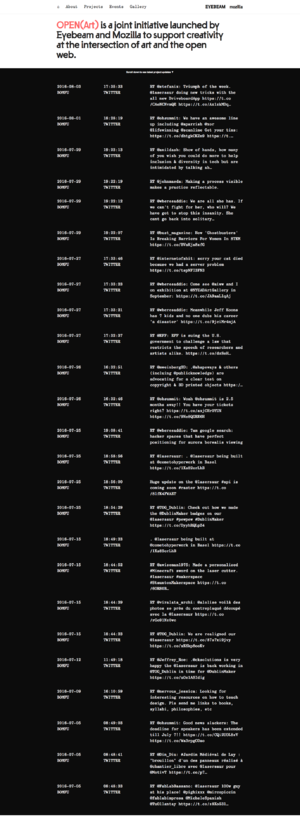Difference between revisions of "OPEN(Art)"
| Line 33: | Line 33: | ||
| − | [[Category: | + | [[Category:On hold]] |
[[Category:Art]] | [[Category:Art]] | ||
[[Category:English]] | [[Category:English]] | ||
Latest revision as of 22:44, 10 June 2017
Self-portrait
OPEN(Art) is a joint initiative launched by Eyebeam and Mozilla to support creativity at the intersection of art and the open web. (http://openart.eyebeam.org/)
Open(Art) is a joint initiative launched by Eyebeam and Mozilla to support creativity at the intersection of art and the open web. It is a unique opportunity for artists and technologists to collaborate on new work that catalyzes creative participation on a global scale. Selected artists and technologists develop projects that push the boundaries of online or networked culture and address contemporary social challenges, while contributing to the community of practice around creative code.
Three Open(Art) Fellows were selected from an open call for proposals, and awarded a $15,000 production budget and resources to develop their projects, including desk space and access to design, research, and fabrication studios at Eyebeam’s New York location. The Fellows' work is presented through an exhibition and workshops taking place at Eyebeam, July 12 – August 11, 2013.
The Open(Art) website will also provide a unique look into their process. Eyebeam Fellow Ramsey Nasser had developed a system for compiling all Open(Art) project activity as one continuous stream of text and visuals taken from the Fellows' social media feeds. (http://openart.eyebeam.org/about/)
Description
OPEN(Art) is an initiative launched by Eyebeam and Mozilla to support creativity in the intersection between art and the internet, so that artists and experts in technology can develop projects that break the barriers between digital culture and communitarian practices of creative coding.
The Eyebeam organization, founded in 1997, is a technology center dedicated to the creation and distribution of media art. So far, it has offered 245 residencies for artists and technological projects, along with generating programmes of education and public exhibitions. Mozilla is a free software community established in 1998 that develops and promotes products with open standards for the public benefit, such as the Firefox search engine.
Eyebeam offered scholarships, workspaces and spaces for exhibition to three art projects to innovate in the use of programming:
Pixel shaders. An interactive book designed by Toby Schachman that serves as an introduction to graphic programming. While the CPU (Central Processing Unit) is the most common topic in programming courses, the GPU (Graphics Processing Unit) is less known, and used for high performance videogames and scientific simulations. The book intends to facilitate the understanding and use of this resource in interactive and playful ways, challenging traditional forms in learning programming.
Meemo. A tool-maker that facilitates and makes the development of apps available to everyone, using an intuitive interface that allow users to hack into applications in order to create theirs or change its operation. Meemo. Designed by Forrest Oliphant, Meemo connects to open-source modules and is completely designed for the web.
BomFu. A collaborative writing tool for bill of materials. Created by Nortd Labs, aims to increase and facilitate quality BOMs (Bill Of Materials), lists of unpublished materials needed to manufacture and end product. It's a open file format aimed at creating and sharing BOMs, that solves requirement problems and multiple views of data issues. The file is completely subject to human editing, motivating users to write their BOMs in a simple text editor.
Links
URL: http://eyebeam.org/projects/openart, http://openart.eyebeam.org/
Wayback Machine: https://web.archive.org/web/*/http://eyebeam.org/projects/openart, http://web.archive.org/web/20160818234027/http://openart.eyebeam.org/
